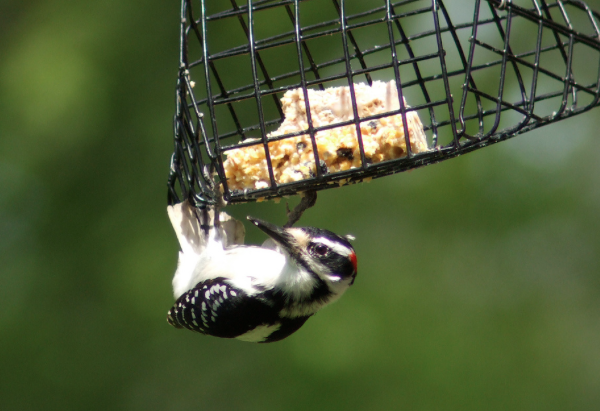
I am fluent in bird. I can tell what bird territory boundaries are in my neighborhood or when an American Robin has spotted a bird eating hawk and when House Sparrows are agitated by Blue Jays are raiding their nests. I can even tell when a bird needs serious help.
In June, storms hit Minneapolis very hard. Some friends had come by to help me lift my window unit air conditioner into my window. After they left, I began securing the flashing around the unit and noted the skies getting dark and green. Suddenly a huge gust of wind hit and blew all the flashing in to my apartment. I watched a large branch fly past my window and break a neighbor’s window. “I should maybe step away from my window,” I thought.
It seemed like a straight line wind type storm and the worst of those last less than a minute. This one didn’t stop. I hid behind my futon while my pet rabbit Dougal peered up at my from beneath it. The power went out and the wind pushed trees down, we heard branches snap and glass shatter outside. And rain flooded my neighborhood.
Literally. This is my street corner. It’s prone to flash flooding and I’ve lived her long enough to know what to avoid.
When the storm finally passed, I met up with my neighbors and we surveyed the immediate damage around our building and watched the hipster underwear dance around the downed trees and flooding. As the sun finally set, we could hear sirens all around us in the dark. The police and the city had their work cut out for them. I would end up being without power for 48 hours.
The next morning, I biked my neighborhood to survey the damage. I knew the storm was bad, but didn’t realize how bad until I saw in the light of day all the trees blocking almost all of the streets. There was really no easy way to get around my neighborhood by car as trees blocked every road. No wonder the sirens were going non stop the night before, the police had some major traffic issues to deal with.
With every downed tree, I wondered about nests. I try to keep a detached eye to that, birds kind of play the odds by having as may young as possible and many times as possible. Most are just not going to survive. I biked past willows where I knew Baltimore Orioles had been nesting and heard young still begging in the branches. There was a noticeable increase of robin chicks blown a few days too early out of the nest but still were tended by the their parents. If they could evade predators, they had a decent chance at survival.
I continued on my way and passed a rather large tree on one of the lakeside bike trails near my home. I heard Hairy Woodpeckers, at first I thought an adult, but then also young. I stopped and inspected the trunk, trying to see where the birds were or where the hole was. I could hear precisely where they were in the trunk, but I couldn’t find the entrance hole. Then I realized, it was on the other side facing the ground, the hole completely blocked. The trunk was too large for me or even four people to budge. The birds were trapped in the dark with no escape. Meanwhile, hundreds of people biked and jogged past, oblivious to the sounds in the trunk.
This is my nightmare. Trapped in a dark, screaming and nothing can help you and perhaps people walk by but they don’t know you need help. I tried stopping joggers and bikers, “Do you live nearby? Do you have a chainsaw?”
Few lived nearby and none had a chainsaw. What could I do? I decided I would pedal towards the sounds of chainsaws to see if someone would help me cut the trunk open. On my way, I managed to flag down a Minneapolis Park and Recreation truck. I explained the situation and asked the driver if he would follow me on my bike to the birds and help. This kind city worker named Dan said, “Yes, I will.”
When we got to the tree, he assessed where the birds could be and said quietly, “I’ve done this before, but sometimes I still cut the birds accidentally.”
To the birds trapped in the dark, a chainsaw is terrifying, they could flutter right into its path as he cut. “I understand,” I said, “but I think a quick death from a chainsaw is better than starving for days in the dark.”
He nodded and continued his assessment. Then Dan deftly cut the tree into a four foot chunk and rolled it over. Silence. I played the hairy woodpecker call on my phone, a chick responded and creeped up towards the entrance. The bird was covered in feathers and looked 12 – 13 days old, the age they leave the nest.
“The best thing would be to leave them here,” I said, “the parents are probably watching us and will come when we leave. If we could lean the trunk up against that tree for two or three days, the chicks will be leave the nest. They may even do it today.”
“Yeah,” Dan said, “I’ll note this tree.”
“Thank you again,” I said, “I know it’s stupid, they’re just birds…”
“Hey,” he interrupted, “I’m a tree guy, of course I love birds.”
He headed off with his chainsaw to continue clearing streets. I moved my bike off the trail and watched. The branch would have fallen sixteen hours ago. Would the parents return? The chicks in the nest continued to call. What a day they must have had. Perhaps they got one last feeding before the loud and windy storm hit. Suddenly the only world they know shifts violently, slamming to the ground and in the dark, they sleep. That’s all they know to do in the dark…but the dark doesn’t end. And they wake up and are hungry in the dark, they call for food like they normally do but the darkness stays and no parent arrives. They can hear their parents calling for them outside, but no food. Meanwhile, the adult birds fly back and forth to where the nest hole used to be, wondering why it’s gone and why they can hear the chicks but can’t find them to feed them. I know I’m not supposed to anthropomorphize, but even that gives me a knot made of barbed wire in my stomach.
The chicks rattled louder and louder, almost sounding like adults. Within five minutes, a surprised adult hairy woodpecker answered as if to say, “Wait, you guys are still alive?”
The parents zipped back and forth over the trunk with beaks full of food, calling to the chicks. They were hesitant to go down to the ground, especially with the oblivious bikers zooming past, but I knew they would soon they would find a way. Either the chicks would hop outside of the nest cavity out of sheer hunger or these urban birds used to people would finally land on the ground. With each pass over the trunk, the adults dipped lower and lower. I left the Hairy Woodpeckers to their chicks and biked home.
Storms always prove two things to me in my neighborhood. One: birds are incredibly resilient creatures. Two: people are still willing to do what it takes to help their neighbor, even if it is just a bird.



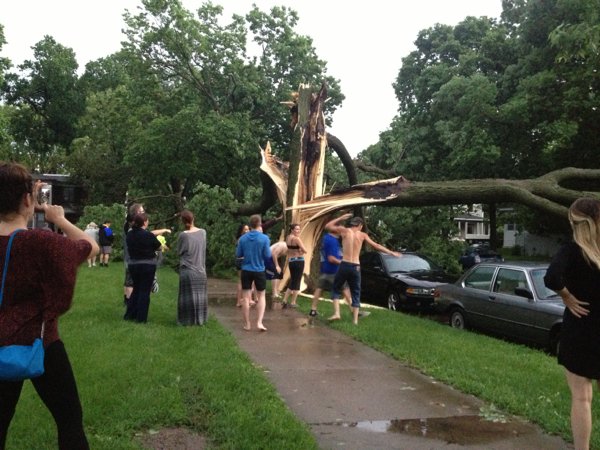
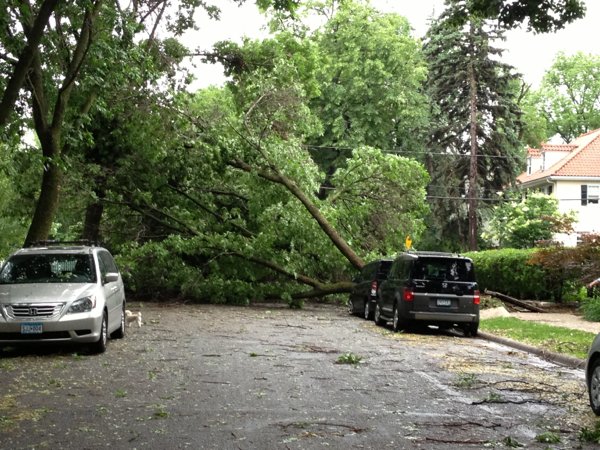
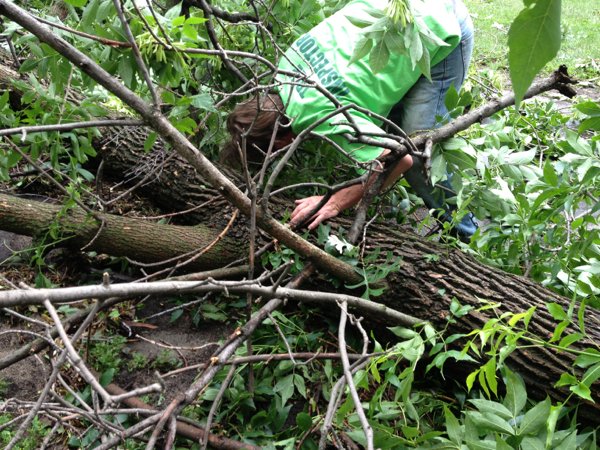
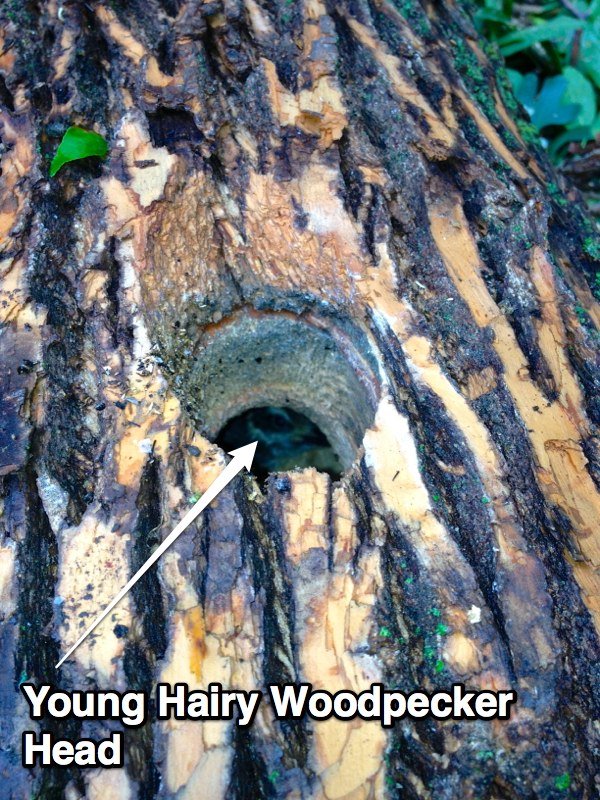











Holding back tears … you (and Dan) are a hero!
I loved this story!! One of my favorite that I’ve ever read on this website!
Sharon, Thanks to you and to Dan for reminding us that Yes, We Can!
What a great story. Thanks for sharing and for you and Dan caring.
Blue Jay can raid all the house sparrow nests they want in my opinion… Just last year we had one whopper of a storm here in Ohio right before the fourth of July. Tornadoes, heavy rain, 100+ degree temps, high humidity, power outages, and even the water was shut off. Pretty nasty stuff. I had a red-bellied woodpecker hole break off in the storm with 5 young ones inside, due to leave that very day. I hope they left before the branch broke off.